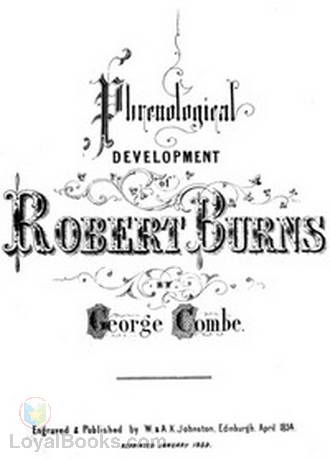Phrenological Development of Robert Burns From a Cast of His Skull Moulded at Dumfries, the 31st Day of March 1834 By: George Combe (1788-1858) |
|---|

The book Phrenological Development of Robert Burns From a Cast of His Skull Moulded at Dumfries, the 31st Day of March 1834 by George Combe offers a unique and intriguing perspective on the Scottish poet Robert Burns. Written almost two centuries ago, this book delves into the pseudoscience of phrenology, which examines the correlation between the shape of the skull and an individual's character traits.
George Combe, a renowned phrenologist of his time, provides readers with a detailed analysis of Burns' skull, aiming to uncover the poet's intellectual and emotional capacities. Combe's methodology involves carefully observing the bumps, indentations, and general structure of the skull to determine the underlying qualities of the individual.
What makes this book intriguing is not only its focus on Robert Burns, a beloved figure in Scottish literature, but also the broader exploration of the phrenological practice prevalent during the 19th century. Combe's extensive research and study of phrenology bring to light the prevailing beliefs regarding the relationship between the physical features of the head and an individual's personality traits.
One of the key strengths of this book is the meticulous attention to detail displayed by Combe. He analyses each section of Burns' skull, discussing the potential implications of its shape on aspects such as the poet's literary genius, creativity, and emotional temperament. Combe's explanations are clear and accessible, allowing readers to follow his line of reasoning and better understand the phrenological theories behind his conclusions.
Additionally, Combe incorporates historical context into his analysis, providing readers with a deeper understanding of the society in which Burns lived. This enriches the book by helping readers grasp the significance of phrenology during that time and how it shaped societal perceptions.
However, it is important to approach this book with caution due to the controversial nature of phrenology. The practice has since been discredited by the scientific community, as it lacks a solid empirical basis and is often associated with racial and social prejudices. Readers should keep in mind that while this book offers a historical perspective, its conclusions need to be evaluated within the context of the time in which it was written.
In conclusion, Phrenological Development of Robert Burns From a Cast of His Skull Moulded at Dumfries, the 31st Day of March 1834 by George Combe is a thought-provoking exploration of phrenology and its application to the analysis of Robert Burns' character. It sheds light on the cultural and scientific beliefs of the 19th century, allowing readers to develop a better understanding of the era. Despite its historical value, readers should approach this book with a critical mindset, keeping in mind the limitations and controversies surrounding phrenology. BY George Combe. Engraved & Published by W. & A.K. Johnston, Edinburgh. April 1834. REPRINTED JANUARY 1859. PHRENOLOGICAL DEVELOPMENT OF ROBERT BURNS, from a Cast of his skull MOULDED AT DUMFRIES. THE 31ST DAY OF MARCH 1834. With Remarks by George Combe, AUTHOR OF "A SYSTEM OF PHRENOLOGY," "THE CONSTITUTION OF MAN" &c. [Illustration: MAUSOLEUM, Erected at Dumfries, to the Memory of Robt Burns] Engraved & Published by W. & A.K. Johnston, Edinburgh 30 April 1834. Reprinted January 1859. [Illustration: VIEWS OF THE SKULL OF ROBERT BURNS.] [Illustration: KEY TO THE PHRENOLOGICAL ORGANS.] OBSERVATIONS ON THE SKULL OF BURNS, BY GEORGE COMBE. Robert Burns was born on 25th January 1759, and died at Dumfries on 21st July 1796, in the 37th year of his age, and, on the 26th, was interred in St Michael's Churchyard. Eighteen years afterwards, a Mausoleum was erected by subscription to his memory in that cemetery; and, on the 19th September 1815, his remains were privately exhumed and transferred to the vault attached to it. Mrs Burns, the Poet's widow, having died on 26th March 1834, the vault was opened for the purpose of depositing her remains beside those of her husband; and the gentlemen who took charge of the proceedings, being aware of the anxiety which had long been generally felt to obtain a Cast of the Poet's Skull, resolved to avail themselves of the opportunity to gratify this desire... Continue reading book >>
|
| eBook Downloads | |
|---|---|
|
ePUB eBook • iBooks for iPhone and iPad • Nook • Sony Reader |
Kindle eBook • Mobi file format for Kindle |
|
Read eBook • Load eBook in browser |
Text File eBook • Computers • Windows • Mac |
| Review this book |
|---|